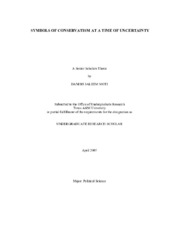| dc.description.abstract | Traditional research on political parties suggests that there are certain routes that each
party should take to secure support for their policies. Republicans have found success by
campaigning on symbols and more abstract issues. Democrats have found success by
picking up issues that reflect the people’s values. These have been the traditional norms
in social politics, but I believe it would be interesting to see how valid these truths are
presently.
The traditional models for political parties are worth examining today because of new
factors that are more relevant than ever before. Some of these elements include terrorism,
national security, and Iraq. There is reason to believe that the models for success have
shifted over time because of the mentioned factors. There are a limited number of issues
that one can expect people to be attentive to. Add the elements brought about after 9/11,
and now it is difficult to balance social issues with foreign policy. Recent politics by both
parties seem to have fallen back on “valance” issues, or simply promoting issues that
there is general consensus for. Furthermore, issues that have no clearly developed sides
are avoided until there is reasonable support for one solution.
James A. Stimson comments on the traditional methods that both parties utilize to find
support for their policies. In his book, Tides of Consent (2004), Stimson explains the
fluctuations in preferences for liberal and conservative policies. He explains that a
sizeable portion of the population still expresses their preference for policy based on the
traditional notions about political parties. Traditional notions still correlate Democrats
with the New Deal politics and increased government spending. Republicans are linked
with shrinking the spending and limiting the influence of the government in the day-today
affairs of the people. However, to even the slightly alert political observer, it is clear
to note that the two parties do not reflect their traditional selves. | en |


